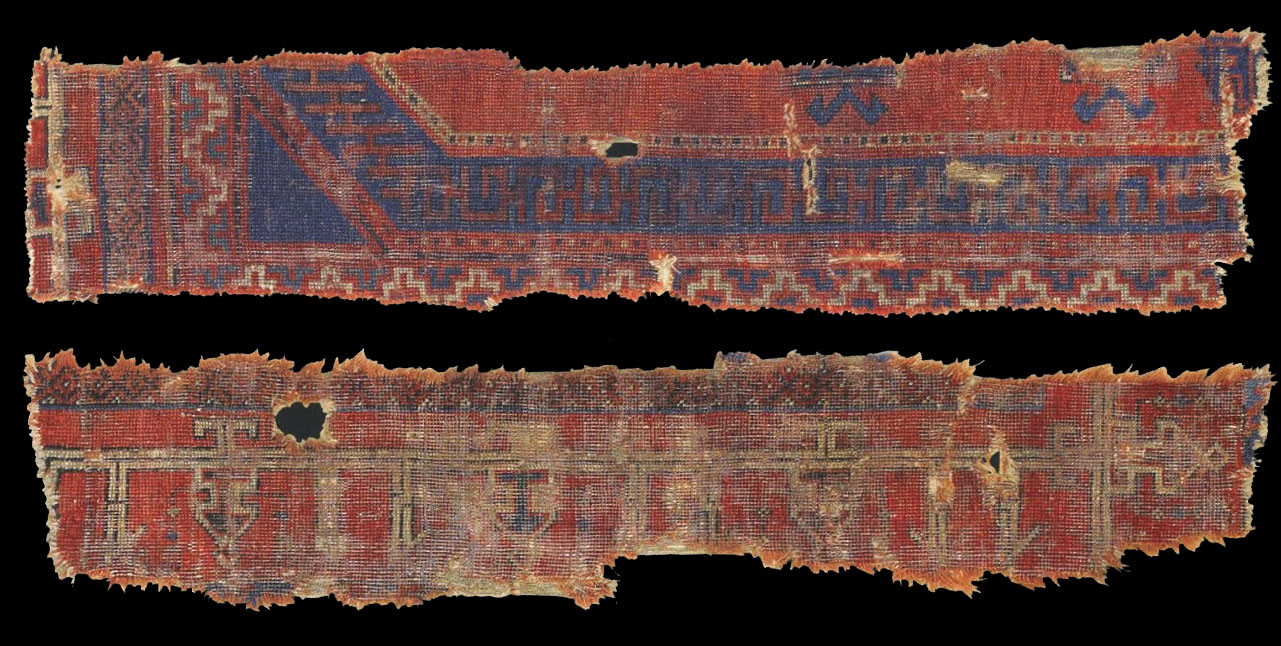|
Ilkhanid period
rug fragments, second half 13th Century, Tabriz, Azerbaijan.
Lot Notes
In the 1990s a very small group of rugs
appeared on the market, all of which were said to come from Tibet. They
were very comparable in design and colouring, and all had very similar
structure. They caused huge excitement when they were first published
since they were thought to be original examples of rugs that were only
known beforehand in European paintings. The majority of them have highly
stylised animals that each has a further animal inside. One, the largest,
formerly in
the Kirchheim Collection, is now in the Museum of Islamic Art, Qatar
(Heinrich E. Kirchheim et al., Orient Stars, A Carpet Collection,
Stuttgart and London 1993, pp.14 and 15); the second is
in the Metropolitan Museum of Art (David Roxburgh, Turks, exhibition
catalogue, London, 2005, pl.98, p.143). Jon Thompson lists
a further
example in a private collection in Genova, another unpublished three
fragments from a
large carpet with prancing horses in the Kirchheim Collection, and a
small fragment in the Pine Collection (list from Jon Thompson, 'Carpets in
the Fifteenth Century', in Carpets and Textiles in the Iranian World
1400-1700, London, 2010, note 54, p.57). The Genoa example is published in
black and white by Jürg Rageth, Anatolian kilims and radiocarbon dating,
Riehen 1999, fig.9, p.166.
The present fragments, which we can be almost certain are originally from
the same rug, clearly comes from the same group. The best preserved
element, the main border, is of exactly the same design and colouring as
the Qatar, Italian and Kirchheim examples. The inner border is also shared
by all four carpets. The Metropolitan rug has been carbon 14 dated to
1040-1290 AD; the Qatar carpet to 1190-1300, and the Italian rug to
1205-1375. These results are all consistent and would support a date of
almost anywhere in the 13th century.
The fourth
carpet however, that remaining in the Kirchheim collection, has been
carbon dated with a result that indicates a date of 1308-1420.
The design of this rug is closely related to that of
the incomplete
carpet remaining in the Kirchheim collection. Each has a similar inner
band that cuts the corner, and from the Kirchheim example it is clear that
this is the edge of an octagon. Our internal design is not the same, and
unfortunately there is not enough remaining to be able to speculate very
far.
Julia Bailey was the first person to suggest in print that these carpets,
which had all been catalogued as Turkish, were in fact Persian, citing the
similarity of an illustration in the Great Mongol Shahnama to the design
of these carpets (Julia Bailey, 'Milestones in the History of Carpets',
Hali 152, summer 2007, pp,140-143). Jon Thompson has recently returned to
this theme, illustrating the Shahnama illustration (Thompson, op. cit.,
pp.50-52). Not only is the field design very similar, but there is an
inner border showing that is almost identical to that on the present rug,
and on the other three noted above. There seems little doubt that it is
one of this group of carpets that is depicted. The only question is
whether it is of local manufacture, or an import.
The Great Mongol Shahnama was dispersed in the early 20th century by the
Belgian dealer Georges Demotte. Nothing remains of the colophon which
might have given information about when and where, and for whom, it was
created. Scholars are however relatively united in dating it to the second
quarter of the 14th century, most concurring with the attribution
suggested by Oleg Grabar and Sheila Blair who argued that it was made for
Ghiyath al-Din b. Humam al-Din Muhammad, the son of Rashid al-Din, the
Ilkhanid vizier who was based in Tabriz, in around 1335. The carpets thus
pre-date this, which is consistent with the carbon date results on the
three "pregnant animal" carpets noted above. Even the early part of the
dating on the Kirchheim carpet is entirely consistent with a date in the
first quarter of the 14th century. The combination of pictorial and
scientific evidence strongly indicates that this is the remains of a royal
Ilkhanid carpets, probably from Tabriz, a remarkable survival.
Lot Description
LOT 101 - TWO FRAGMENTS FROM AN ILKHANID RUG
PERSIA, PROBABLY TABRIZ, SECOND HALF 13TH OR EARLY 14TH CENTURY
From the same rug, overall uneven wear, partly corroded colours, a few
holes and tears, mounted
3ft.7in. x 8½in. (109cm. x 22cm. ) and 3ft.8in. x 9in. (112cm. x 24cm.)
(2)
Provenance:
London market circa 1998.
Price Realized £55,250 ($88,953)
Sale Information
SALE 7960
ORIENTAL RUGS AND CARPETS INCLUDING TURKMEN WEAVINGS FROM THE COLLECTION
OF ERIK RISMAN
5 April 2011
London, King Street
|

